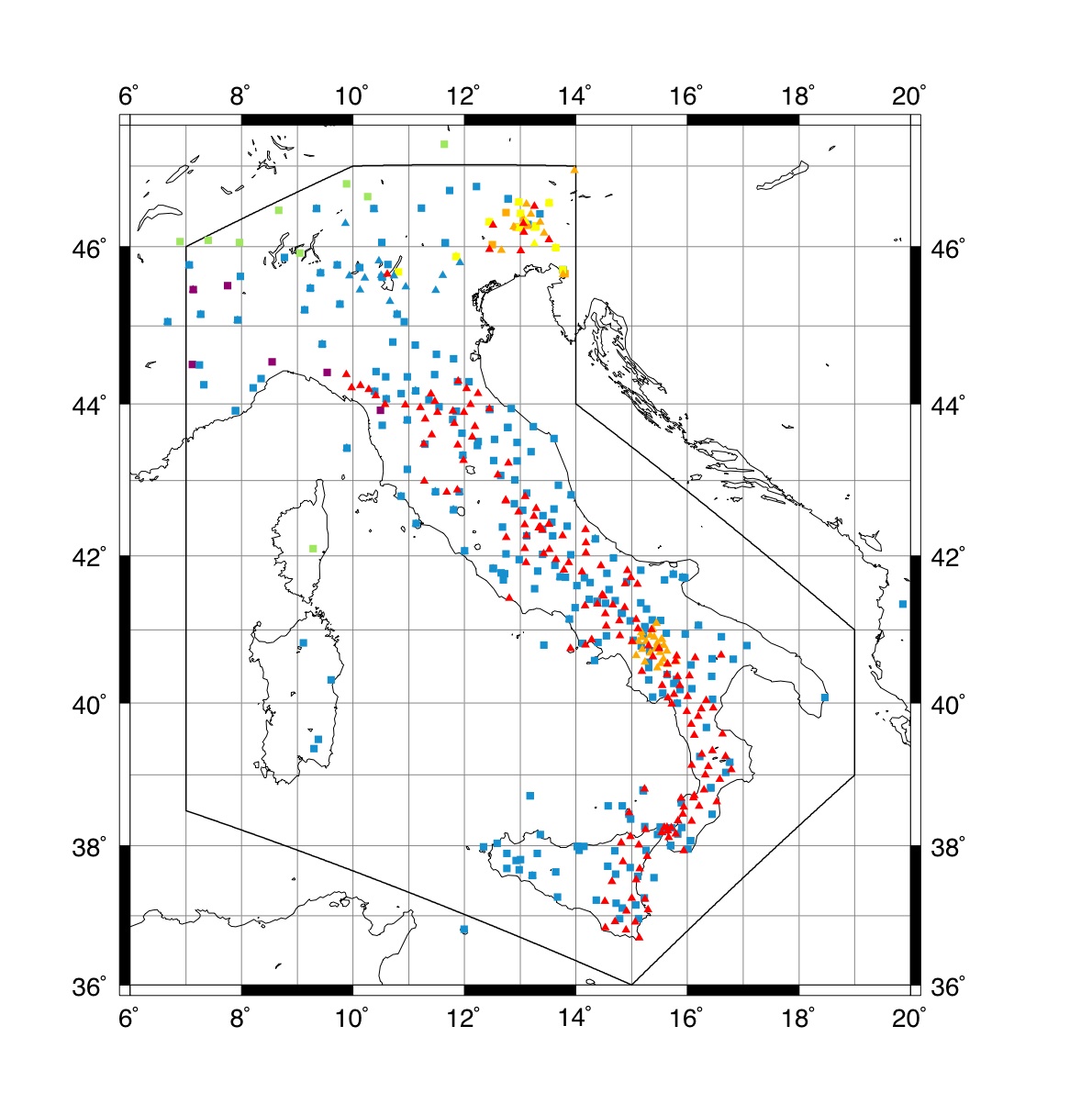Task 1 - Data availability, distribution and archiving
Objectives
The primary goal of this task is to share the available data and the source parameters (e.g., hypocenter, magnitude, active fault plane) among the research units (RU) that have implemented the ShakeMap package and that, on a routine basis, determine maps of strong ground motion shaking.
Data are considered either the complete recorded waveforms or the parametric peak ground motion (PGM) data extracted from the waveforms (e.g., PGA, PGV, PSA).
Background
In Italy, there are various networks (broadband, BB, and strong motion, SM) run by different public organizations (mainly research institutions and universities). In the DPC-S4 2005-2007 project some poor coordination between the different shakemap centers and networks resulted eventually. This was very evident for strong motion data exchange among the different partners of the project. Since the data are essential to generate accurate shakemaps, this "status quo" hampered in the end the success of the DPC-S4 2005-2007 project.
Existing Data
The map below shows the stations of the current BB and SM networks operating in Italy. All together there are more than 600 sites and about 480 are equipped with digital acquisition systems.

The Rete Accelerometrica Nazionale (RAN) run by the "Dipartimento per la Protezione Civile" can be considered the backbone, strong motion network in Italy including ~470 stations. Out of these stations and currently (January 2008), 210 stations are equipped with digital data loggers, 130 digital stations will be installed by 2008 and about 130 are analogic stations inherited from the ENEL original network. To these stations we must add all those that have been installed by local organizations such as regions, provinces, universities and research institutions.
Activity
For the full waveforms, the data will be acquired and distributed by setting up some dedicated SeedLink servers at the INGV data center. This kind of data exchange is well established, it has been in place for several years for the MedNet data and it is now about to be extended to all the BB and SM data operated by the INGV “Centro Nazionale Terremoti” sited in Rome which runs the Italian National Seismic Network, INSN (network code IV). The PGM data can be either determined locally at the station or they can be extracted from the waveforms at the central acquisition center. In any event, the parametric data need to be archived within databases which schema and tables will be shared among the participants since the very beginning of the project in order to insure maximum homogeneity among the ShakeMap® installations.
The source parameters (i.e., hypocenter, magnitude and rupturing fault for M>5.5 earthquakes) need also to be shared among the participants in order to insure homogeneity of the shakemaps. For example, since earthquake location and magnitude both depend on parametric data extracted from the recorded waveforms, either a phase data exchange among the institutions or an authoritativeness scheme based on regional and "solution quality indexes" will be implemented. Since the data must be shared among the different RU it is thought the use of open source, seismology dedicated software such as EIDS (Earthquake Information Distribution System) or, analogously, message passing software such as or “spread” (http:// www.spread.org). EIDS is in use, for example, at the California Integrated Seismic Network and it has been designed to be a highly configurable system that can meet many message delivery needs while providing redundancy. A prerequisite of EIDS is that the messages are XML formatted. To this regard, it has been recently developed QuakeML as a standardized XML for seismology. By pursuing this choice for data exchange, the project will exploit the benefits deriving from the adoption of recognized standards (e.g., EIDS and QuakeML are used within the I3 project NERIES for parametric data exchange). Other alternatives include the use of open source, message passing software such as “spread” which is currently in use within the SeisComP3 data acquisition software developed at GFZ for parametric data exchange.
Overall, these approaches should insure that when an earthquake occurs the various institutions recording the data can promptly make available their data and acquire those of the other participating networks. To this purpose it will be basic the establishment of SEEDlink servers for waveform data exchange between DPC and INGV. The same SEEDlink protocol will be also adopted by the other shakemap processing centers if other means for data exchange are not already in place. Transparent data exchange between DPC and INGV will be also of great benefit to the activities of the concomitant project S4. For parametric data sharing, implementation of EIDS (or analogous data exchange procedure) will be tested and implemented through the course of the project. Regardless of the means for data exchange, a database of event PGM parameters recorded by the stations used in the generation of the shakemaps will be compiled and made available to DPC.
First Annual Meeting: 19-21 October 2009